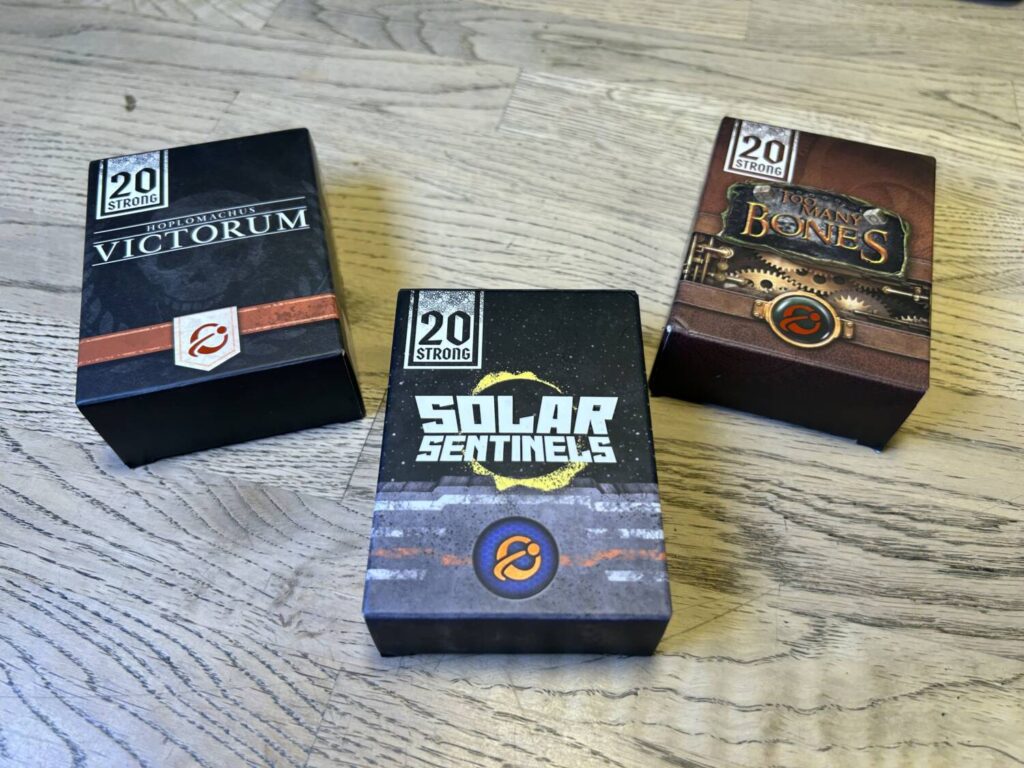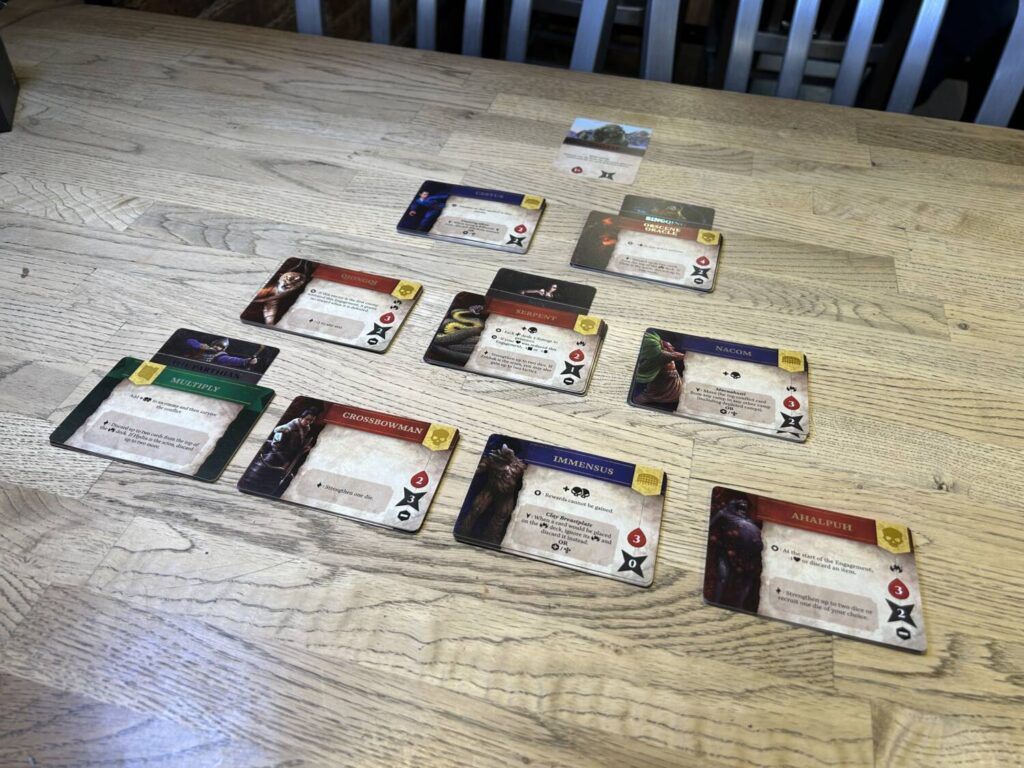Disclosure: Meeple Mountain received a free copy of this product in exchange for an honest, unbiased review. This review is not intended to be an endorsement.
Here we have 20 Strong from Chip Theory Games, best known as the publisher of Too Many Bones. Most of Chip Theory’s catalogue doesn’t speak to me, but I was immediately interested when they announced 20 Strong in late 2022.
It checked two big boxes for me. First, it’s a small design. I’m a sucker for a small design. Not only that, it’s a small design from a publisher known for enormous designs, which made me all the more curious. Second, it’s a modular system, rather than a game. 20 Strong consists of 20 dice and a poker chip, along with a basic set of rules. The specifics of play change from game to game, depending on what deck of cards you use.

When I spoke to Chip Theory at PAXU in December of last year, they talked about all the ways the system might develop. The first deck was a tower defense game, but the others could be whatever designers wanted. An economy game. A resource management game. A trick-taking game. Absolutely anything.
Starting Hand
At the moment, there are three decks for 20 Strong. Solar Sentinels comes with the system, while decks based on Too Many Bones and Hoplomachus Victorum are sold separately. All three, to my disappointment, are tower defense games. You fight a string of bad guys until you’re ready to take on the final boss.

You start by picking a character, who comes with starting stats and a special ability. The stats are pretty simple to understand: Health is how much damage you can take before losing, Strategy controls your inventory size and the number of times you can re-roll during a fight, and Recovery dictates the rate of return for your used dice. Three of 20 Strong’s twenty dice are used to track these stats, which can go up or down as the game progresses.
The other seventeen are used to fight. You pick which dice you want from your pool, keeping in mind the hit rates of the various colors. Yellow dice are the least likely to connect, while your lone red provides a guaranteed hit. The dice include accommodations for the colorblind, in the form of color-specific rings on each die face. You roll and assign hits, then take damage if any enemies are left standing.
The fights are spiced up by the enemy abilities, which can interact in all sorts of interesting ways. They might cap the number of dice you can use per roll, or cause you to lose items, or bring more monsters into the fight. Most enemies also come with a reward for defeating them. Some happen instantly, while others can be turned into items in your inventory. Managing enemy abilities and rewards is the true puzzle of 20 Strong.

The Road More or Less Exclusively Traveled By
I had a blast with Solar Sentinels for my first few plays. It was tight, tense, and brutal, at least while I was learning. Now, about five plays in, I’m disappointed by how easy it is. Even as I turn up the heat by raising the difficulty level, victory feels assured. Everything is manageable. Compare that to Resist!, another recent small box solo game with similar rules overhead and a 20-minute playtime. I’ve played Resist! twice as many times as 20 Strong, and I still can’t reliably come out on top. I think I’ve won twice?
It seems in 20 Strong like mistakes are the only things that generate interesting decisions. Most of the fun in my first few games came from accidentally allowing absurdly powerful combinations of enemies to manifest on the table. Now I know how to look out for that, so it rarely comes up. Once you’ve got a firm grip on how the system works, you can coast through.
I’ve settled into a routine: get my Recovery rate as high as possible, and throw all my dice at the problem. Nothing in any of the three decks drives me to vary from that approach. Hoplomachus Victorum almost does something different, through a system where most of the enemies you defeat for bonuses also make the final boss more powerful, but that game includes a way to skip any enemies that don’t suit your needs that’s fairly low-risk.
High Recovery basically breaks the game. It would probably become much more interesting in the long run if certain creatures fed off of a high Recovery rate. The beauty of a modular system like this is that there’s always the chance that someone will do that in the future. The game just needs a patch.

A Nod Is as Good as a Wink
I guess my fundamental issue is that, after five games of Solar Sentinals, I knew how to reliably win both Hoplomochus and Too Many Bones on my first play. There was some novelty, but all the challenge was gone. They’re too similar, despite their differences. My guess is that the system became more rigid during development than was originally intended, but I don’t know that.
If you’re a Chip Theory fan, you probably already ordered 20 Strong. If you’re looking for a great, quick, tense solo game that gets better with familiarity, I’d steer you towards the inimitable Under Falling Skies. If you want a solo game that gives you more of a sense of narrative as you play, Resist! does that beautifully.
None of this is to say you shouldn’t consider 20 Strong. Nearly all solo games wear out their charm eventually. You’re not meant to be able to play them forever. If you’re interested in 20 Strong, I don’t think you’ll regret the purchase. My rating of 3.5 is the result of a bifurcation. My initial experiences with Solar Sentinels were a solid 4, and now I’d rate just about everything involved here at a 3. Most people don’t play any given game much more than I played Sentinels, though, so that 4 may be everything you need to know.
I know I’ll be keeping an eye on what Chip Theory comes up with for 20 Strong going forward. I just wish my gaze had been able to linger in the present a bit longer.













I want some good solo games. But the last few have either been unmanageable (meaning your choices have little bearing on the outcome), or the producer had little interest in decent production values.
You bring up a couple of contenders I will keep in mind. As for 20 Strong, I will skip it.
Thanks for a great review.
I’m also very happy to make recommendations if you’re looking for some longer solo games to try! Thanks as always for reading.
Thanks for sharing. I haven’t quite reached the point where I’m just coasting through, though I agree maxing out the refresh stat is a great path to victory, almost every time. Instead I’ve found the variable abilities of heros and adding missions does freshen up gameplay and force me to explore new avenues to victory.
I’m intrigued by what this game system can become, but I agree there’s not as significant as a gameplay experience difference between the decks that are currently available.